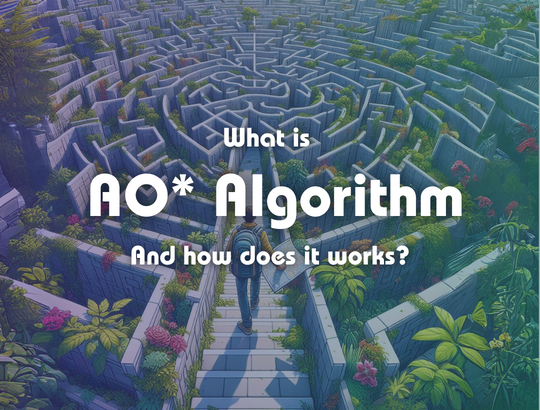Table of Contents
Why AO-Star Algorithm?

Imagine you’re in a maze, looking for the exit. A normal search algorithm would try every path until it finds the way out. But what if the maze keeps changing? Walls appear and disappear, The map you have might not be entirely accurate, there could be hidden dangers or shortcuts you don’t know about. This is where the AO* algorithm comes in, like a trusty guide who can help you find the best path even when the conditions changes.
What is AO* Algorithm?
The AO* algorithm, short for “Anytime Repairing A*” or “Anytime Optimistic” is a type of search algorithm used in artificial intelligence and robotics for solving pathfinding problems in a graph or network. It is an extension of the A* algorithm, which is widely used for finding the shortest path between nodes in a graph.
The primary goal of AO-Star Algorithm is to find an optimal path between a start node and a goal node while minimizing the computational resources required. It achieves this by performing a best-first search, similar to A*, but with the added capability of being able to incrementally improve the solution as more computational resources become available.
How it is different from A* Algorithm?
Like A* Algorithm, AO-Star Algorithm utilizes heuristics to guide the search towards the goal efficiently. However, unlike A*, AO* is designed to work with graphs or search spaces where the heuristic function may not always be accurate or consistent.
The key feature of AO* is its ability to handle inadmissible or inconsistent heuristic functions, which means that the heuristic might overestimate or underestimate the actual cost to reach the goal. To accommodate this, AO* employs a technique called “anytime optimization.” It continually updates its search based on new information to refine its estimate of the optimal solution.
Anytime Repairing A* or Anytime Optimistic? Which terminology is correct?
The term “AO*” or “AO-Star Algorithm” can indeed stand for “Anytime Repairing A*” or “Anytime Optimistic”, depending on the context and the specific variant of the algorithm being discussed. Both interpretations are valid and are used in different contexts within the field of artificial intelligence and robotics.
- Anytime Repairing A*:
- In this interpretation, “AO*” refers to “Anytime Repairing A*.” This variant of the algorithm focuses on continuously repairing or improving the current solution as more computational resources become available. It incrementally refines the solution while maintaining optimality guarantees.
- Anytime Optimistic:
- Alternatively, “AO*” can also stand for “Anytime Optimistic.” In this context, the algorithm maintains an optimistic view of its current solution and continuously seeks to improve it within the given time or resource constraints. It aims to provide an optimal or near-optimal solution within the available resources.
Core Concept of AO* Algorithm

- Break it Down:AO-Star Algorithm uses a special kind of graph called an AND-OR graph to represent the search space. This graph breaks down the problem into smaller sub-problems, making it easier to handle.
- AND Nodes: These represent subgoals that must all be achieved to reach the final goal. Think of them as checkpoints you need to pass through.
- OR Nodes: These represent different ways to achieve a subgoal. Imagine multiple paths leading to the same checkpoint.
- Informed Search: AO* is an informed search algorithm, meaning it uses a heuristic to estimate the cost of reaching the goal from any point. This heuristic is like a good guess, guiding the search towards the most promising paths.
- Adapting to Change: The magic of AO* lies in its ability to adapt. If the environment changes (e.g., a wall appears), AO* can re-evaluate the costs of affected paths and adjust its search accordingly. It doesn’t have to start from scratch, saving time and effort.
How AO* Algorithm works?
- Initialization:
- Start State: It begins from a starting point, representing the current state of the problem or the initial position in a graph.
- Evaluation
- Cost Estimates: Each state is assigned an “optimistic” cost.
- f(n) = g(n) + h(n)
- g(n): Actual cost of reaching node n from the initial state.
- h(n): Estimated cost of reaching the goal from node n (heuristic).
- Cost Estimates: Each state is assigned an “optimistic” cost.
- Expansion:
- Priority Queue: AO* uses a priority queue, often implemented as a binary heap, to keep track of states that need to be expanded. States in the queue are prioritized based on their 𝑔∗(𝑠)g∗(s) values, with lower values indicating higher priority.
- Selecting a State: AO* repeatedly selects the state with the lowest 𝑔∗(𝑠)g∗(s) value from the priority queue. This state represents the most promising path found so far.
- Expanding a State: Once a state is selected, AO* generates its successor states, which are the states reachable from the current state by taking valid actions or moving along edges in the graph. These successor states are generated and evaluated.
- Updating Cost Estimates: For each successor state, the algorithm updates its 𝑔∗(𝑠)g∗(s) value based on the cost of reaching that state from the current one and the 𝑔∗(𝑠)g∗(s) value of the current state.
- Adding to Priority Queue: The newly generated states, along with their updated 𝑔∗(𝑠)g∗(s) values, are added to the priority queue.
- Termination:
- The search process continues until certain termination conditions are met, such as:
- A predefined time limit is reached.
- A user request to stop and return the best solution found so far.
- The discovery of an optimal solution that satisfies the problem constraints.
- The search process continues until certain termination conditions are met, such as:
- Solution Retrieval:
- AO-Star Algorithm can return solutions incrementally. At any point during the search, the user can decide to stop the algorithm and retrieve the best solution found so far. This feature is valuable in real-time systems where immediate responses are needed.
- Adaptation:
- AO* is adaptable to available computational resources and user requirements. It can adjust its search strategy:
- If more time or computational power is available, AO* can perform a more exhaustive search to improve the solution quality.
- If resources are limited, it can return a solution quickly without completing the entire search.
- AO* is adaptable to available computational resources and user requirements. It can adjust its search strategy:






Nice explanation 👍🏼